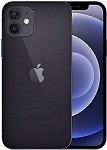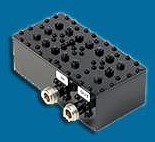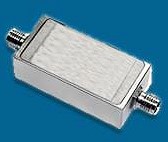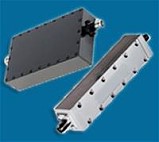|

Sam Benzacar of Anatech Electronics, an RF and microwave filter company, has published
his September 2023 newsletter that features his short op-ed entitled "Wi-Fi: More
Than High-Speed Connectivity." In it, Sam discusses the pervasive use of existing
and planned WiFi networks for use in monitoring and tracking applications. The IEEE
has created a new standard,
IEEE 802.11bf, which "... Aims to Enable a New Application of WLAN Technology:
WLAN Sensing." "This standardization project aims to enhance the reliability and
efficiency of WLAN sensing and establish interoperability of wireless devices to
enable a wide range of new and useful applications. Measurements obtained with WLAN
sensing can be used to support new industrial and commercial applications in semiconductor
manufacturing, enterprise networking, and test and measurement equipment." As the
bands become more populated with users, stricter filtering will be needed, and that's
where Anatech's expertise comes in.
A Word from Sam Benzacar - Wi-Fi: More Than High-Speed Connectivity
 By Sam Benzacar By Sam Benzacar
As Wi-Fi data rates get faster with each generation, the technology is often
faster than the broadband sources supporting it. However, there's a lot more going
on with Wi-Fi than speed. For example, Wi-Fi has recently gotten a lot of attention
for its ability to track the presence and movement of people and objects. This capability,
called Wi-Fi sensing, detects signal reflections and other disruptions, and uses
machine learning algorithms to analyze them to determine who (or what) is moving
and in what direction. As Wi-Fi sensing uses existing hardware and doesn't require
cameras or other sensors for detection, it's a lot less expensive and almost effortless
to deploy.
While multiple sensing technologies have been available for many years, the characteristics
of wireless technologies give Wi-Fi sensing distinct advantages. For example, wireless
sensing works in non-line-of-sight conditions and supports wider coverage areas
compared to infrared-based sensing. Unlike video-based sensing, wireless sensing
can operate in poor visibility and lighting conditions and preserve user's privacy.
In contrast to other wireless sensing technologies, Wi-Fi sensing leverages the
fact that Wi-Fi is a low-cost and widely deployed technology. It's also standardized,
which allows multi-vendor interoperability and supports data communications, ranging,
and sensing with a single chipset.
As a result, it shouldn't be surprising that it's being widely adopted throughout
many markets, from healthcare to retail, hospitals, home automation, and others.
For security applications, Wi-Fi sensing can detect unauthorized access to a specific
area, and when unexpected movement is detected, the system triggers alarms or sends
alerts. It can also be integrated into smart home systems to automate tasks such
as turning lights on and off, adjusting thermostats, or activating home security
systems.
In healthcare, it can be used for patient monitoring by tracking a person's movements
to help with fall detection and medication adherence. In retail settings, Wi-Fi
sensing can help businesses collect data on customer behavior and foot traffic patterns,
and the resulting data can be analyzed to gain insights into human behavior, occupancy
patterns, and trends that lead to improved store layouts and marketing strategies.
Wi-Fi sensing has become so pervasive that the IEEE has created an amendment
to the IEEE 802 standard called IEEE 802.11bf that's designed to remove roadblocks
to Wi-Fi sensing adoption posed by the fact that the IEEE 802 standard has never
defined sensing-specific features. Consequently, it was limited to proprietary implementations
with limited interoperability. Specifically, the amendment defines an interface
for sensing applications to request and obtain sensing measurements, allows for
sensing applications to use devices by multiple vendors, and lowers the overhead
associated with obtaining sensing measurements, among other features.
France Says iPhone 12 Exceeds Radiation Limits
 French regulators ordered
Apple to stop selling the iPhone 12 because it emits electromagnetic radiation above
EU standards. Apple disputes the findings and says the phone has been certified
by multiple international bodies and complies with all applicable regulations and
standards for radiation worldwide. The National Frequency Agency (ANFR) said it
will monitor device updates, and if they do not work, Apple will have to recall
the phones. The iPhone 12's radiation levels are safe, according to France's digital
minister, and acknowledged that its tests don't reflect typical phone use but said
the phone's radiation levels are still well below levels that could cause harm.
An update will be released to prevent iPhone 12 radiation exposure from surpassing
the limit. French regulators ordered
Apple to stop selling the iPhone 12 because it emits electromagnetic radiation above
EU standards. Apple disputes the findings and says the phone has been certified
by multiple international bodies and complies with all applicable regulations and
standards for radiation worldwide. The National Frequency Agency (ANFR) said it
will monitor device updates, and if they do not work, Apple will have to recall
the phones. The iPhone 12's radiation levels are safe, according to France's digital
minister, and acknowledged that its tests don't reflect typical phone use but said
the phone's radiation levels are still well below levels that could cause harm.
An update will be released to prevent iPhone 12 radiation exposure from surpassing
the limit.
LoRaWAN Sets New Transmission Record
 The LoRaWAN world record
for transmission distance of 517 mi has just been surpassed, with the new record
standing at 830 miles with LoRaWAN trackers on a fishing boat on buoys on the coast
of Portugal contacting a gateway in the Canarian Islands. What's even more impressive
is that the record was set at sea level rather than a high-altitude balloon, which
was the case for the previous record. LoRa technology operates in the ISM bands
at 868 and 915 MHz. The STMicroelectronics STEVAL-STRKT01 LoRa IoT tracking device
used in the test is typically employed in applications covering up to 100 m. The LoRaWAN world record
for transmission distance of 517 mi has just been surpassed, with the new record
standing at 830 miles with LoRaWAN trackers on a fishing boat on buoys on the coast
of Portugal contacting a gateway in the Canarian Islands. What's even more impressive
is that the record was set at sea level rather than a high-altitude balloon, which
was the case for the previous record. LoRa technology operates in the ISM bands
at 868 and 915 MHz. The STMicroelectronics STEVAL-STRKT01 LoRa IoT tracking device
used in the test is typically employed in applications covering up to 100 m.
Verizon, T-Mobile Corner 5% of U.S. FWA Market
 According to Leichtman
Research Group, Verizon and T-Mobile fixed wireless broadband now control 5.2% of
the U.S. home internet market. The pair added 893,000 fixed wireless access users
in the second quarter, bringing their number of subscribers to 5.9 million, twice
the 2.244 million they had a year ago. However, as more consumers adopt these services,
the technology's capacity issues may present a problem. Performance has improved
marginally to 33 to 182 Mb/s since T-Mobile Home Internet launched a year ago, with
download speeds from 35 to 115 Mb/s and upload speeds between 6 and 23 Mb/s. According to Leichtman
Research Group, Verizon and T-Mobile fixed wireless broadband now control 5.2% of
the U.S. home internet market. The pair added 893,000 fixed wireless access users
in the second quarter, bringing their number of subscribers to 5.9 million, twice
the 2.244 million they had a year ago. However, as more consumers adopt these services,
the technology's capacity issues may present a problem. Performance has improved
marginally to 33 to 182 Mb/s since T-Mobile Home Internet launched a year ago, with
download speeds from 35 to 115 Mb/s and upload speeds between 6 and 23 Mb/s.
MIT Develops Underwater Network
 MIT researchers have
developed ultra-low-power underwater networking and communication technology that
uses piezoelectric materials and a Van Atta array to transmit acoustic signals at
kilometer-plus ranges without a battery. This technology could be used for various
applications, such as underwater monitoring, tracking, and communication. Van Atta
arrays are a series of connected piezoelectric sensors that can triangulate and
redirect signals back toward their source. This makes them more efficient than acoustic
devices that transmit data omnidirectionally, leading to energy loss and shorter
ranges from signal scatter. The acoustic sensors measure 3 x 3 ft. and can simultaneously
reflect multiple signals at distances up to about 5 km. MIT researchers have
developed ultra-low-power underwater networking and communication technology that
uses piezoelectric materials and a Van Atta array to transmit acoustic signals at
kilometer-plus ranges without a battery. This technology could be used for various
applications, such as underwater monitoring, tracking, and communication. Van Atta
arrays are a series of connected piezoelectric sensors that can triangulate and
redirect signals back toward their source. This makes them more efficient than acoustic
devices that transmit data omnidirectionally, leading to energy loss and shorter
ranges from signal scatter. The acoustic sensors measure 3 x 3 ft. and can simultaneously
reflect multiple signals at distances up to about 5 km.
Anatech Electronics Introduces a New Line of Suspended
Stripline and Waveguide Type RF Filters
Check out Our Filter Products



Cavity Band Pass Filters
LC Band Pass Filters Cavity Bandstop/Notch Filter
About Anatech Electronics
Anatech Electronics, Inc. (AEI) specializes in the design and manufacture of
standard and custom RF and microwave filters and other passive components and subsystems
employed in commercial, industrial, and aerospace and applications. Products are
available from an operating frequency range of 10 kHz to 30 GHz and include cavity,
ceramic, crystal, LC, and surface acoustic wave (SAW), as well as power combiners/dividers,
duplexers and diplexers, directional couplers, terminations, attenuators, circulators,
EMI filters, and lightning arrestors. The company's custom products and capabilities
are available at www.anatechelectronics.com.
Contact:
Anatech Electronics, Inc.
70 Outwater Lane
Garfield, NJ 07026
(973)
772-4242
sales@anatechelectronics.com
Posted August 17, 2023
|



























 By Sam Benzacar
By Sam Benzacar French regulators ordered
Apple to stop selling the iPhone 12 because it emits electromagnetic radiation above
EU standards. Apple disputes the findings and says the phone has been certified
by multiple international bodies and complies with all applicable regulations and
standards for radiation worldwide. The National Frequency Agency (ANFR) said it
will monitor device updates, and if they do not work, Apple will have to recall
the phones. The iPhone 12's radiation levels are safe, according to France's digital
minister, and acknowledged that its tests don't reflect typical phone use but said
the phone's radiation levels are still well below levels that could cause harm.
An update will be released to prevent iPhone 12 radiation exposure from surpassing
the limit.
French regulators ordered
Apple to stop selling the iPhone 12 because it emits electromagnetic radiation above
EU standards. Apple disputes the findings and says the phone has been certified
by multiple international bodies and complies with all applicable regulations and
standards for radiation worldwide. The National Frequency Agency (ANFR) said it
will monitor device updates, and if they do not work, Apple will have to recall
the phones. The iPhone 12's radiation levels are safe, according to France's digital
minister, and acknowledged that its tests don't reflect typical phone use but said
the phone's radiation levels are still well below levels that could cause harm.
An update will be released to prevent iPhone 12 radiation exposure from surpassing
the limit.  The LoRaWAN world record
for transmission distance of 517 mi has just been surpassed, with the new record
standing at 830 miles with LoRaWAN trackers on a fishing boat on buoys on the coast
of Portugal contacting a gateway in the Canarian Islands. What's even more impressive
is that the record was set at sea level rather than a high-altitude balloon, which
was the case for the previous record. LoRa technology operates in the ISM bands
at 868 and 915 MHz. The STMicroelectronics STEVAL-STRKT01 LoRa IoT tracking device
used in the test is typically employed in applications covering up to 100 m.
The LoRaWAN world record
for transmission distance of 517 mi has just been surpassed, with the new record
standing at 830 miles with LoRaWAN trackers on a fishing boat on buoys on the coast
of Portugal contacting a gateway in the Canarian Islands. What's even more impressive
is that the record was set at sea level rather than a high-altitude balloon, which
was the case for the previous record. LoRa technology operates in the ISM bands
at 868 and 915 MHz. The STMicroelectronics STEVAL-STRKT01 LoRa IoT tracking device
used in the test is typically employed in applications covering up to 100 m.  According to Leichtman
Research Group, Verizon and T-Mobile fixed wireless broadband now control 5.2% of
the U.S. home internet market. The pair added 893,000 fixed wireless access users
in the second quarter, bringing their number of subscribers to 5.9 million, twice
the 2.244 million they had a year ago. However, as more consumers adopt these services,
the technology's capacity issues may present a problem. Performance has improved
marginally to 33 to 182 Mb/s since T-Mobile Home Internet launched a year ago, with
download speeds from 35 to 115 Mb/s and upload speeds between 6 and 23 Mb/s.
According to Leichtman
Research Group, Verizon and T-Mobile fixed wireless broadband now control 5.2% of
the U.S. home internet market. The pair added 893,000 fixed wireless access users
in the second quarter, bringing their number of subscribers to 5.9 million, twice
the 2.244 million they had a year ago. However, as more consumers adopt these services,
the technology's capacity issues may present a problem. Performance has improved
marginally to 33 to 182 Mb/s since T-Mobile Home Internet launched a year ago, with
download speeds from 35 to 115 Mb/s and upload speeds between 6 and 23 Mb/s.  MIT researchers have
developed ultra-low-power underwater networking and communication technology that
uses piezoelectric materials and a Van Atta array to transmit acoustic signals at
kilometer-plus ranges without a battery. This technology could be used for various
applications, such as underwater monitoring, tracking, and communication. Van Atta
arrays are a series of connected piezoelectric sensors that can triangulate and
redirect signals back toward their source. This makes them more efficient than acoustic
devices that transmit data omnidirectionally, leading to energy loss and shorter
ranges from signal scatter. The acoustic sensors measure 3 x 3 ft. and can simultaneously
reflect multiple signals at distances up to about 5 km.
MIT researchers have
developed ultra-low-power underwater networking and communication technology that
uses piezoelectric materials and a Van Atta array to transmit acoustic signals at
kilometer-plus ranges without a battery. This technology could be used for various
applications, such as underwater monitoring, tracking, and communication. Van Atta
arrays are a series of connected piezoelectric sensors that can triangulate and
redirect signals back toward their source. This makes them more efficient than acoustic
devices that transmit data omnidirectionally, leading to energy loss and shorter
ranges from signal scatter. The acoustic sensors measure 3 x 3 ft. and can simultaneously
reflect multiple signals at distances up to about 5 km. 




